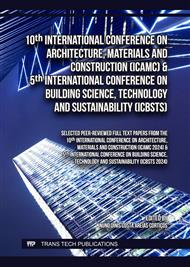p.3
p.13
p.19
p.27
p.33
p.41
p.47
p.55
Experimental Investigation of Lightweight Mortars Based on Recycled Olive Kernel through Hygric and Mechanical Characterization
Abstract:
Bio-based building materials are now being widely explored by researchers to promote their effective use and reduce the environmental impact of building construction. Among these, mortars based on olive kernel aggregate, a waste product of the production of olive oil, can be effectively adopted for moderate load-bearing applications in buildings thanks to their lower density and thermal conductivity,compared to traditional sand-based mortars. Nevertheless, to date most of the researchers focused on mortars produced with a partial substitution of traditional sand with olive kernels and relatively high dosages of binder. In this work, mortars entirely based on olive kernel aggregate were produced employing limited dosages of binder. Mechanical, hygric properties and the density were evaluated on the hardened materials for different tested formulations. Results showed a high dependency of mechanical properties on the dosage of binder and demonstrated their employability for moderate load-bearing applications in buildings.
Info:
Periodical:
Pages:
27-32
Citation:
Online since:
January 2025
Price:
Сopyright:
© 2025 Trans Tech Publications Ltd. All Rights Reserved
Share:
Citation:


